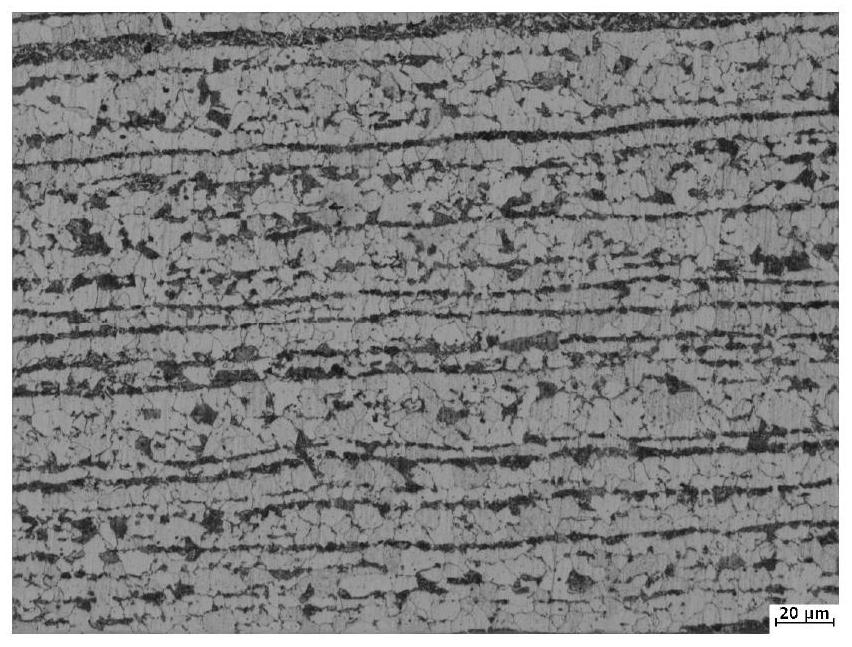Wear-resistant steel and production method thereof
A production method and wear-resistant steel technology, which is applied in the field of steel production, can solve problems such as sudden brittle fracture, high strength, and delayed cracks, and achieve the goals of refining the grain size of the structure, solving stress defects, and avoiding phase transition cracks Effect
- Summary
- Abstract
- Description
- Claims
- Application Information
AI Technical Summary
Problems solved by technology
Method used
Image
Examples
Embodiment 1
[0030] A wear-resistant steel provided in this embodiment has the following chemical composition and mass percentage: C: 0.23%, Si: 0.41%, Mn: 0.86%, P: 0.011%, S: 0.001%, Nb: 0.031%, V: 0.001%, Ti: 0.016%, Cr: 0.51%, Ni: 0.020%, Mo: 0.21%, Al: 0.041%, B: 0.0016%, Mg: 0.0015%, N: 0.0021%, the balance is Fe and unavoidable of impurities.
[0031] Its manufacturing method includes the following steps:
[0032] S1. The molten iron after desulfurization is smelted in a smelting furnace, deoxidized and alloyed by LF, and then sent to RH vacuum treatment. The vacuum degree is not more than 3.0mbar. After meeting the vacuum degree requirements, the vacuum treatment time is 18 minutes. After the vacuum is completed, magnesium-aluminum wire is used for magnesium treatment. Stir statically for 15min after magnesium treatment;
[0033] S2. After the molten steel is transported, it is sent to the continuous casting station for casting. The superheat of the tundish is 23°C, the continuou...
Embodiment 2
[0039] The chemical composition and mass percentage of a wear-resistant steel provided in this embodiment are as follows: C: 0.36%, Si: 0.29%, Mn: 0.76%, P: 0.010%, S: 0.001%, Nb: 0.051%, V : 0.001%, Ti: 0.021%, Cr: 0.65%, Ni: 0.002%, Mo: 0.13%, Al: 0.048%, B: 0.0019%, Mg: 0.0016%, N: 0.0041%, the balance is Fe and not Avoid impurities.
[0040] Its manufacturing method includes the following steps:
[0041] S1. The molten iron after desulfurization is smelted in a smelting furnace, deoxidized and alloyed by LF, and then sent to RH vacuum treatment. The vacuum degree is not more than 3.0mbar. After meeting the vacuum degree requirements, the vacuum treatment time is 21min. After the vacuum is completed, magnesium aluminum wire is used for magnesium treatment. Stir statically for 15min after magnesium treatment;
[0042] S2. After the molten steel is transported, it is sent to the continuous casting table for casting. The superheat of the tundish is 23°C, the continuous casti...
Embodiment 3
[0048] The chemical composition and mass percentage of the wear-resistant steel provided in this embodiment are as follows: C: 0.19%, Si: 0.27%, Mn: 1.2%, P: 0.013%, S: 0.002%, Nb: 0.013%, V : 0.005%, Ti: 0.012%, Cr: 0.51%, Ni: 0.03%, Mo: 0.31%, Al: 0.039%, B: 0.0023%, Mg: 0.0017%, N: 0.0029%, the balance is Fe and not Avoid impurities.
[0049] Its manufacturing method includes the following steps:
[0050] S1. The molten iron after desulfurization is smelted in a smelting furnace, deoxidized and alloyed by LF, and then sent to RH vacuum treatment. The vacuum degree is not more than 3.0mbar. After meeting the vacuum degree requirements, the vacuum treatment time is 17min. After the vacuum is completed, magnesium aluminum wire is used for magnesium treatment. After the magnesium treatment, static stirring was performed for 16 min;
[0051] S2. After the molten steel is transported, it is sent to the continuous casting table for casting. The superheat of the tundish is 19°C, ...
PUM
 Login to View More
Login to View More Abstract
Description
Claims
Application Information
 Login to View More
Login to View More - R&D
- Intellectual Property
- Life Sciences
- Materials
- Tech Scout
- Unparalleled Data Quality
- Higher Quality Content
- 60% Fewer Hallucinations
Browse by: Latest US Patents, China's latest patents, Technical Efficacy Thesaurus, Application Domain, Technology Topic, Popular Technical Reports.
© 2025 PatSnap. All rights reserved.Legal|Privacy policy|Modern Slavery Act Transparency Statement|Sitemap|About US| Contact US: help@patsnap.com

